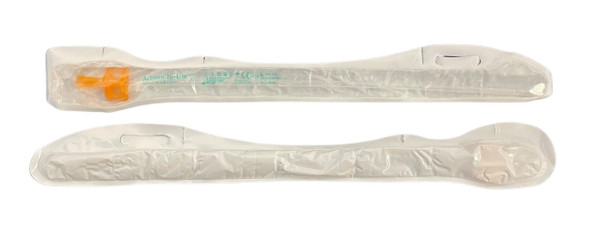Description
Also Available in CH08-CH16 (2.7-5.3mm)
Description
Actreen® Mini Cath is a short urinary catheter designed for female self catheterization. It’s an easy and ready to use catheter with a feminine and modern design. Pouches are included in each box for more discretion in which patients can carry their daily quantity of catheters.
- Sterile ready-to-use mini catheter: 9 cm long catheter (length not including connector)
- Pre-lubricated catheter, no need to add water
- Easy to open using pre-cut
- Easy to use
- Smooth eyelets at the tip for deep bladder emptying
Specification
- Sterile ready-to-use mini catheter: 9 cm long catheter (length not including connector)
- Universal connector: Fits all types of urine bags
- Short connector allows hygienic catheterization and avoids contact with toilets
- PVC-free, DEHP-free
FAQ
A catheter is inserted into a female's bladder through the urethra. This procedure is performed by a healthcare provider and is usually done in a medical setting, such as a hospital or clinic.
The following is a general overview of the process:
- The patient will be positioned in a comfortable position, such as lying on her back with her knees bent and legs apart.
- The healthcare provider will clean the genital area with an antiseptic solution to reduce the risk of infection.
- The provider will gently insert the catheter into the urethra, guiding it towards the bladder.
- Once the catheter is in place, the healthcare provider will inflate the balloon on the end of the catheter to keep it in place.
- The patient may experience some discomfort or pressure during the procedure, but this should be minimal.
- The healthcare provider will attach a bag to the end of the catheter to collect urine.
It is important to note that a catheter should only be inserted by a trained healthcare professional and with proper sterile technique to reduce the risk of infection.
The size of the catheter used for a female patient depends on several factors, including the patient's age, anatomy, and the reason for the catheterization. The following are general guidelines for selecting the appropriate size of catheter:
- Pediatric patients: For female infants and children, smaller sizes of catheter are usually used, ranging from 5 to 8 French (Fr).
- Adults: For adult females, the most commonly used size is 10-14 Fr. Larger sizes may be necessary for women with larger anatomy, or for those undergoing certain medical procedures.
It is important to note that the size of the catheter should be determined by a healthcare professional, as improper sizing can lead to complications, such as pain, discomfort, or trauma to the urethra. The healthcare provider will consider the patient's medical history and current condition to determine the appropriate size of catheter.
There are several types of catheters that are used for female patients, including:
- Intermittent catheters: These are short, flexible catheters that are inserted into the bladder and removed once the bladder is emptied. Intermittent catheters are typically used for short-term or temporary bladder drainage.
- Indwelling catheters: These are catheters that are inserted into the bladder and left in place for a period of time, usually several days to several weeks. Indwelling catheters are typically used for longer-term bladder drainage and for patients who are unable to empty their bladder on their own.
- Foley catheters: This is a type of indwelling catheter that has a small balloon on the end that is inflated to keep the catheter in place.
- Suprapubic catheters: Suprapubic catheters: These are catheters that are inserted through a surgical incision in the lower abdomen and into the bladder. Suprapubic catheters are typically used for patients who have a condition that makes it difficult or impossible to use a catheter inserted through the urethra.
- Clean Intermittent Self-Catheterization (CISC): This is a type of intermittent catheterization where the patient is trained to insert and remove the catheter themselves. CISC is typically used for patients who have difficulty emptying their bladder on their own, but who are able to perform the catheterization themselves.
The type of catheter used for a female patient will depend on her individual needs and the recommendation of her healthcare provider.
The frequency of changing a female catheter depends on several factors, including the type of catheter being used, the patient's individual needs, and the recommendation of the healthcare provider.
For indwelling catheters, the recommendation is to change the catheter every three to four weeks, or sooner if it becomes dislodged, contaminated, or if the patient develops an infection.
For intermittent catheters, the frequency of change will depend on how often the patient is using the catheter and how long they are keeping the catheter in place. In general, the catheter should be changed after each use to reduce the risk of infection.
In some cases, a healthcare provider may recommend using a closed system catheter, which has a sterile collection bag attached directly to the catheter. This type of catheter can remain in place for several days and reduces the risk of infection.
It is important to follow the recommendations of the healthcare provider and to keep the catheter and surrounding area clean and free from contamination to reduce the risk of infection.













